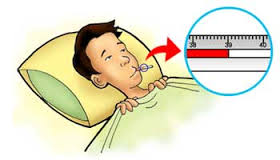Example Procedure Text

– Example Procedure Text How to Reduce a Fever Without Medication. Hai Sobat Englishclas, Bagaimana kabar kalian semuanya? Semoga masih dalam keadaan baik semua. Maaf jika dalam beberapa bulan ini admin off update artikel karena ada beberapa pekerjaan yang harus diselesaikan terlebih dahulu. Sok sibuk kali ya… hehehehe
Udahan dulu basa-basinya. Oke sobat englishclas, pada kesempatan kali ini kita akan melanjutkan beberapa materi tentang yang sudah lama tertunda lumayan lama.dan pada kesempatan kali ini saya akan menambahan satu artikel tentang contoh dari teks Procedure.
Example Procedure Text How to Reduce a Fever Without Medication
1. Cooling Down
- Take a warm or lukewarm bath. Start off by drawing a warm bath. Have the person suffering from the fever get in and relax while the warm temperature of the water slowly drops. Because the temperature of the water drops slowly, the person cools down slowly as well.
- Do a wet sock treatment. This method works best overnight. Take a pair of pure cotton socks long enough to cover the ankles and thoroughly wet the socks in cold running water. Wring out all excess water and put the socks on. Cover these cotton socks with pure wool socks to supply insulation. The person wearing the socks should rest in bed for the rest of the night. They should be covered with a blanket as well.
- Use a wet towel treatment. Take one or two hand towels and fold lengthwise. Soak the towels in either very cold or ice water. Wring out the excess water and wrap the towel around the head, around the neck, around the ankles or around the wrists. Don’t use the towels over more than two areas– that is, use the towel around the head and the ankles or around the neck and wrists. Otherwise, you may cool down TOO much.
2. Adjusting Diet to Reduce Fever
- Cut back on eating. The old adage, “feed a cold, starve a fever” actually has some truth to it, according to recent scientific studies. You don’t want to waste the body’s energy for digestion when that energy should be used to control the infection that’s causing the fever.
- b. Snack on healthy fruits. Choose fruits such as berries, watermelon, oranges and cantaloupe. These are rich in Vitamin C, which can help fight infections and lower fever. They’ll also help keep you hydrated.
- Eat some soup. While you can have chicken broth on its own, you could also eat chicken soup with rice and some vegetables. Studies have shown that chicken soup may actually have medicinal properties.It will also help keep you hydrated.
- Drink plenty of water. Fever can lead to dehydration which can make the sufferer feel worse. Avoid dehydration by drinking plenty of water or an oral rehydration solution like CeraLyte, Pedialyte. Call your physician before you do and ask your doctor’s advice. Be prepared with a list of symptoms and about how much you or your child has been eating, drinking and how high the fever has been. Also keep track of how often you have to change diapers or, for an older children, how often they have to urinate.
- Drink an herbal tea fever reducer. You can either buy these teas or make them yourself. Simply add a teaspoon of dried herb for every cup of water. Steep the herb in boiled water for 5 minutes and flavor as desired with lemon and honey. Avoid adding milk, since dairy products tend to increase congestion. For small children, reduce the herbs to ½ a teaspoon and make sure the tea has cooled down! Don’t use teas with infants, except with the advice of a physician. Try an herbal tea made from the following herbs:[7]
3. Recognizing When to Get Medical Attention
- Know when to call your doctor. Body temperature can vary throughout the day, but a normal temperature is considered 98.6oF or 37oC. The recommendation[8] in infants less than 4 months old is that if they have a rectal temperature of 100.4oF (38oC) or more,immediately call your physician for advice. For children of any age, if their rectal temperature is 104oF(40oC) or more, immediately call your physician for advice. Any child 6 months or older with a fever of 103oF(39.4oC) should also be seen. If your child has any fever along with any of the following symptoms, call your doctor (or emergency services) as soon as possible:
- Watch for signs of mild dehydration. Call your physician for advice even if you are just seeing the signs of mild dehydration, especially in babies. These can become serious dehydration pretty quickly. Symptoms of mild dehydration include:
- Recognize severe dehydration. If you see any of these, call emergency services and your physician right away. Severe dehydration symptoms include:
- Look for febrile seizures in infants. A febrile seizure is a convulsion that can happen in babies with a fever. They are scary, but usually over very quickly and do not cause any brain damage or major harm. (Source: http://www.wikihow[dot]com/Reduce-a-Fever-Without-Medication)
Sekian Dulu artikel tentang Example Of Procedure Text. Semoga bermanfaat. Terima kasih
Advertisements




